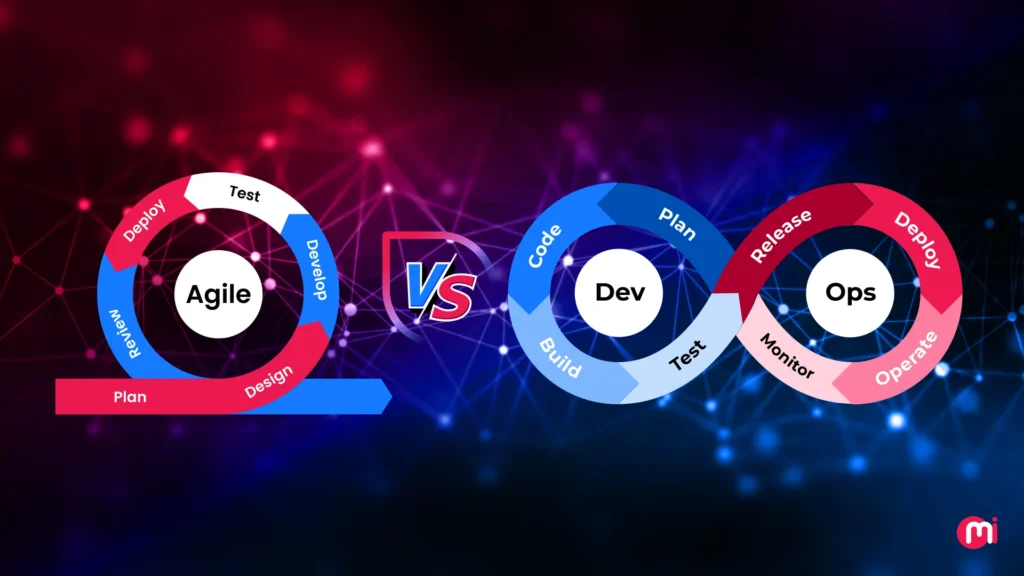Are you leading a tech initiative where speed, collaboration, and continuous improvement are top priorities for your enterprise? If you’re stuck between choosing DevOps vs Agile as software development methodologies, it’s essential to understand the differences, benefits, and challenges of each. In this comprehensive guide on DevOps vs Agile, we will break down both methodologies, compare them from a business perspective, and provide insights on when to choose each and how they can work together effectively.
If you’re still under the impression that Agile and DevOps are the same in terms of software development, or if you’re unsure about which methodology is the right fit for your next project, this article is tailored for you. There is often confusion surrounding the overlapping outcomes, team dynamics, process versus tooling, lifecycle focus, and business context of Agile and DevOps.
While both Agile and DevOps aim to accelerate software delivery and enhance product quality, they follow different paths to achieve these goals and sometimes even form alliances. Therefore, choosing the right methodology between Agile and DevOps for your project is crucial for its success.
Let’s delve into the specifics of these two software development methodologies and frameworks to help you make an informed decision.
Understanding Agile Methodology
When we talk about Agile software development, we think of flexibility, collaboration, and customer-centric delivery. However, the reality of Agile methodology is more nuanced. Agile is a software development methodology aligned with the values and principles of the Agile Manifesto. It focuses on iterative development and cross-functional team collaboration to deliver solutions.
Unlike traditional approaches like the Waterfall model that prioritize building an entire product at once, Agile teams work in small, manageable increments known as "iterations" or "sprints," typically lasting 1 to 4 weeks. Examples of Agile methodologies include Scrum, Kanban, Extreme Programming (XP), and Feature-driven Development (FDD).
Agile is not a specific process or tool; it’s a mindset or framework based on the Agile Manifesto, emphasizing core values and principles. These core values and principles guide Agile teams in their development process, emphasizing the importance of individuals and interactions, functioning software, customer collaboration, and embracing change.
Pros and Cons of Agile Methodology
The key benefits of Agile methodology include faster time-to-market, active customer involvement throughout the project, adaptability to changing requirements, enhanced team collaboration, improved product quality, and risk reduction. However, Agile also comes with challenges such as high commitment and discipline requirements, less predictability in timelines and deliverables, and the potential for scope creep.
Exploring the DevOps Methodology for Continuous Delivery
DevOps, short for Development and Operations, is a practice that fosters collaboration between IT teams and developers to streamline software delivery processes. DevOps aims to break down silos between development and operations teams to enable faster and more reliable software releases.
The DevOps lifecycle focuses on shortening the software development lifecycle, increasing deployment frequency, and ensuring high software quality. DevOps achieves this through continuous automation and a CI/CD (continuous integration and continuous delivery/deployment) pipeline. This pipeline automates workflows for building, testing, integrating, and releasing code in production environments.
DevOps works by bringing together teams to define goals, features, and tasks, writing code in small increments, automating testing and integration, setting up infrastructure using code, deploying code with zero downtime, monitoring software performance, and addressing errors promptly.
Benefits of DevOps
DevOps offers several advantages, including faster product time-to-market, improved team collaboration, higher deployment frequency, better product quality and reliability, scalability and flexibility for microservices and cloud-native development.
However, DevOps also presents challenges such as cultural resistance to change, complexity in setting up pipelines, potential cost increases, security vulnerabilities, and the need for effective team collaboration and shared responsibility.
Key Differences Between Agile and DevOps
While Agile and DevOps share common goals of accelerating software delivery, they differ in their purpose and focus, team structure, processes and workflows, tools, feedback and improvements, automation, security, and scalability. Agile focuses on the development process, while DevOps is concerned with the entire software delivery lifecycle.
Key Similarities Between Agile and DevOps
Despite their differences, Agile and DevOps share common principles such as delivering value to customers quickly and continuously, breaking down team silos, leveraging automation, emphasizing fast feedback, data-driven decision-making, promoting a culture of learning and evolution, and prioritizing quality software delivery.
When Do Agile and DevOps Work Together?
Agile and DevOps can work together effectively when streamlining the software development lifecycle, achieving faster time-to-market, incorporating continuous feedback, implementing a DevSecOps culture, and fostering collaboration and shared ownership. By combining Agile’s flexibility and customer-centric approach with DevOps’ automation and efficiency, organizations can create a high-performance software delivery culture.
Summing Up
Deciding between Agile and DevOps depends on your project needs, goals, and structure. Agile is ideal for projects requiring flexibility, continuous feedback, and rapid iteration, while DevOps excels in automating deployments, enhancing operational reliability, and speeding up release cycles. By using both methodologies together, organizations can leverage the strengths of each to achieve faster, reliable, collaborative, and continuous software delivery.
How MindInventory Supports Agile and DevOps Implementation
MindInventory offers expertise in implementing Agile and DevOps practices to help businesses streamline their software development cycles, enhance collaboration, and achieve faster, more reliable software delivery. Our team provides tailored solutions from consultation to implementation, ensuring that your project aligns with your goals, tech stack, security requirements, and budget. With a focus on continuous improvement and customer satisfaction, we deliver high-quality software solutions that meet the demands of modern software engineering.
FAQs About DevOps vs Agile
- Are DevOps and Agile the same?
No, DevOps and Agile are not the same. Agile focuses on iterative development and customer feedback, while DevOps emphasizes collaboration between development and operations teams for reliable software delivery. - Which is faster, Agile or DevOps?
DevOps is generally considered faster than Agile in terms of software delivery due to its support for CI/CD. - Is DevOps replacing Agile?
No, DevOps builds upon Agile principles and extends collaborations between developers and operations teams. - Can we use both Agile and DevOps?
Yes, using both Agile and DevOps together often produces the best results. - Which is better, Agile or DevOps?
The choice between Agile and DevOps depends on your project needs and goals. - Will DevOps end in the future?
DevOps is unlikely to end as software delivery becomes more complex, necessitating integrated development and operations practices to meet modern software engineering demands.In conclusion, choosing the right software development methodology, whether Agile, DevOps, or a combination of both, is essential for achieving your project objectives. By leveraging the strengths of Agile and DevOps, organizations can streamline their software development processes, enhance collaboration, and deliver high-quality, reliable software solutions effectively.

